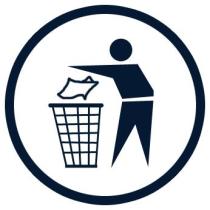Waste is one of those words that is so widely used we often forget to question what it really means. It may only be five letters long but it’s a big word. It can be used as a verb, noun or adjective to refer to a substance or object, thoughtlessness, a missed opportunity or inefficiency. Waste can be solid, liquid or gas and can be hazardous or toxic. And while there’s lots of different ways that we use the term ‘waste’ colloquially, on my quest to define ‘zero waste’ I wanted to find out what officially and legally constituted waste.
Within waste literature it’s easy to find definitions for solid, hazardous, medical and other specific types of waste but it’s virtually impossible to find official definitions for the singular term ‘waste.’ In U.S. legislation, the Solid Waste Disposal Act and relevant sections of the Code of Federal Regulations provide long lists of definitions for commonly understood terms such as “construction” and “person” yet fail to define the key term ‘waste.’ After spending far too long buried within legalese, I came across some EPA call-centre training materials that revealed my search was futile – as they stated that the common term ‘waste’ is most often referred to as ‘solid waste.’
So I set out to investigate the meaning of ‘solid waste.’ My first discovery was that solid waste doesn’t have to be solid. Semi-solids, liquids and contained gaseous material can also be classified as solid waste. But how do we know that any of these substances are wastes? Well…the official regulatory definition states that solid waste is “any discarded material” which has been abandoned or is “inherently waste-like” (Title 40: Protection of Environment, Part 261, § 261.2).*
This left me scratching my head – just because something is discarded automatically means it’s waste? But what about the idiom ‘one man’s trash is another man’s treasure?’ If I discard a perfectly usable tool just because I didn’t have a use for it, would it be waste? What if I discard my perfectly good jeans just because they didn’t fit? What if someone abandoned the Mona Lisa in a parking lot because they didn’t like the look of her smirk – would this classic piece of art simply be declared as a ‘solid waste’?
The problem with this official definition and understanding of ‘waste’ is that it disregards the potential value of abandoned or discarded material. It leaves no room for perspective or creativity. It also suggests that some items will eternally be designated as waste due to ‘inherent’ properties with no regard to how such items may be transformed, repaired or used.
Now it’s important that I recognize that there are a multitude of complex reasons for the specific articulation of terms within regulations and legal documents. For example, someone has to clean up abandoned material. By designating discarded/abandoned materials as solid waste ensures that someone (i.e. municipalities) bears responsibility. Furthermore, there are a number of exemptions and subsection details/cross references listed within the federal regulations that are beyond my comprehension as a layperson and beyond the scope of this reflection.
But with that admission aside, I think waste is a pretty important term and it deserves a more comprehensive official and legal explanation. When we label an item as waste (or not) it sets the value and fate of that item. Just because one person doesn’t see value doesn’t mean that someone else won’t. In my work I’ve attempted to redefine waste as anything that is “unusable, unwanted and unrecyclable” and while this definition may not be perfect either, I offer it as a starting place from which we can start to talk about what really constitutes waste.
*The definition of solid waste also states that recycled materials (yup!) and military munitions are solid waste. The inclusion of recycled material is one worth exploring further. There are, of course, several exemptions for the use or reuse of material and the EPA documents state that designation as solid waste is meant to refer to materials that are “recycled in particular manners (i.e., used in a manner constituting disposal, burned for energy recovery, reclaimed, and speculatively accumulated)” (EPA, 2001).


There is no waste in Nature. ‘Mother’ would never allow that to happen.
Here is a try: From the post-industral human perspective,waste is the last fraction of material(s) that have no value after all resources have been analyzed & separated from the original mass (liquid, solid or gas). .
Thanks Bruce. I agree, with nature being a primary example of zero waste in action we see that in nature there are no ‘unusable, unwanted or unrecyclable’ elements.
You’ve provided another good definition of ‘waste.’ And using that definition I think the zero waste community can then say that we need to design to ensure that within all processes there are no remnants without value.
I explore the issue of design here: https://urbanbandit.wordpress.com/zero-waste-element-four-waste-is-evidence-of-poor-design/
More information on a potential updated EPA solid waste definition – http://www.solidwastemag.com/news/epa-sends-solid-waste-definition-rule-to-white-house-for-review/1000406935/
Interesting perspective. In some countries, there is almost no concept of waste, as far as I have experienced (e.g. in Pakistan, where my daughter’s dad’s family make use of almost everything rather than throwing it away).
Yes, that’s very true. Same with languages too where no words exist for waste.
I have read so many articles on the topic of the blogger
lovers except this post is truly a good article, keep it up.